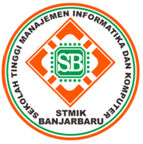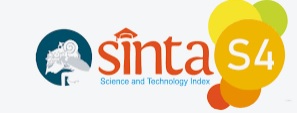Prediksi Tingkat Produksi Batu Quarry Andesite Dengan Metode ARIMA
Abstract
The process of taking andesite quarry stones carried out by PT Pipit Jaya Abadi is erratic so that it is not optimal for the use of existing machines and human resources. If this continues, the company cannot reach the predetermined target. This research aims to assist PT Pipit Jaya Abadi in achieving predetermined production targets and the stability of the quality of production machines so that machine performance can reach optimal levels and maximize existing human resources. ARIMA (Autoregressive Integrated Moving Average) method to forecast the production level of andesite quarry in the coming period. Production data from January 2017 to September 2022 is used in this study. The forecasting results provide an overview of the expected production levels for the next 5 months, namely from October 2022 to February 2023. The forecasting results show production of 24464.344877 m3, 22449.959502 m3, 21969.910870 m3, 21691.556209 m3, and 21849.566221 m3 respectively. Accuracy analysis using MAPE (Mean Absolute Percentage Error) shows an accuracy level of 35.46%.
Keywords: andesite quarry; Production and Forecasting; ARIMA Method
Abstrak
Proses pengambilan batu quarry andesite yang dilakukan oleh PT. Pipit Jaya Abadi tidak menentu sehingga tidak optimal untuk penggunaan mesin dan sumberdaya manusia yang ada. Jika hal tersebut berlanjut membuat perusahaan tidak dapat mencapi target yang telah ditetapkan. Penelitian ini bertujuan untuk membantu PT. Pipit Jaya Abadi dalam mencapi target produksi yang telah ditentukan dan stabilitas kualitas mesin produksi agar kinerja mesin dapat mencapai tingkat optimal serta memaksimalkan sumber daya manusia yang ada. Metode ARIMA (Autoregressive Integrated Moving Average) untuk meramalkan tingkat produksi quarry andesite di periode yang akan datang. Data produksi dari Januari 2017 hingga September 2022 digunakan dalam penelitian ini. Hasil peramalan memberikan gambaran tingkat produksi yang diharapkan selama 5 bulan ke depan, yaitu dari Oktober 2022 hingga Februari 2023. Hasil peramalan menunjukkan produksi sebesar 24464.344877 m3, 22449.959502 m3, 21969.910870 m3, 21691.556209 m3, dan 21849.566221 m3 secara berturut-turut. Analisis akurasi menggunakan MAPE (Mean Absolute Percentage Error) menunjukkan tingkat akurasi sebesar 35,46%.
Kata kunci: Andesite quarry; Produksi dan Peramalan; Metode ARIMA
References
M. Rianto and R. Yunis, “Analisis Runtun Waktu Untuk Memprediksi Jumlah Mahasiswa Baru Dengan Model Random Forest,” Paradig. - J. Komput. dan Inform., vol. 23, no. 1, pp. 85–92, 2021, doi: 10.31294/p.v23i1.9781.
T. Oktarina and Rasmila, “Peramalan Produksi Crude Palm Oil (Cpo) Menggunakan Metode Arima Pada Pt. Sampoerna Agro Tbk,” Semin. Nas. Sist. Inf. Indones., no. November, pp. 252–260, 2018.
M. E. Rosadi, D. Agustini, M. Farida, and D. D. Anjani, “Analisis Penerapan Neural Network dalam Memprediksi Produksi Bijih Nikel di Indonesia,” vol. 4, no. 1, pp. 40–50, 2022.
K. Alloto’dang, S. Syamsuddin, and Ahyuna, “SISTEM PENENTUAN JUMLAH PRODUKSI EMAS MURNI ANTAM DENGAN MENGGUNAKAN METODE TREND LINEAR,” vol. 1, no. 5, pp. 537–546, 2020.
S. Y. Nababan and M. Harahap, “Implementasi Metode Tsukamoto Pada Analisis Prediksi Hasil Kelapa Sawit,” J. Penelit. Tek. Inform. Univ., vol. 3, no. April, pp. 414–423, 2020.
W. Kh. Arabo and O. M. Malallah, “The Effect of Data Splitting Methods on Classification Performance in Wrapper-Based Gene-Selection Model,” Acad. J. Nawroz Univ., vol. 11, no. 4, pp. 284–293, 2022, doi: 10.25007/ajnu.v11n4a1424.
umnadmin, “Mahasiswa Perlu Tahu, Ini Pentingnya Python untuk Berkarir di Bidang Data Science,” Universita Multimedia Nusantara, 2022. https://www.umn.ac.id/mahasiswa-perlu-tahu-ini-pentingnya-python-untuk-berkarir-di-bidang-data-science/ (accessed Jun. 10, 2023).
L. R. de Araújo Morais and G. S. da Silva Gomes, “Forecasting daily Covid-19 cases in the world with a hybrid ARIMA and neural network model,” Appl. Soft Comput., vol. 126, p. 109315, 2022, doi: 10.1016/j.asoc.2022.109315.
Q. M. Abdulqader, “Forecasting the Ratio of the Rural Population in Iraq Using Box-Jenkins Methodology,” Sci. J. Univ. Zakho, vol. 11, no. 1, pp. 132–136, 2023, doi: 10.25271/sjuoz.2023.11.1.1124.
S. S. Olofintuyi, E. A. Olajubu, and D. Olanike, “An ensemble deep learning approach for predicting cocoa yield,” Heliyon, vol. 9, no. 4, p. e15245, 2023, doi: 10.1016/j.heliyon.2023.e15245.
X. Wen, M. Jaxa-Rozen, and E. Trutnevyte, “Accuracy indicators for evaluating retrospective performance of energy system models,” Appl. Energy, vol. 325, no. August, p. 119906, 2022, doi: 10.1016/j.apenergy.2022.119906.
V. E. Sathishkumar, A. G. Ramu, and J. Cho, “Machine learning algorithms to predict the catalytic reduction performance of eco-toxic nitrophenols and azo dyes contaminants (Invited Article),” Alexandria Eng. J., vol. 72, pp. 673–693, 2023, doi: 10.1016/j.aej.2023.04.007.
T. Makoni, G. Mazuruse, and B. Nyagadza, “International tourist arrivals modelling and forecasting: A case of Zimbabwe,” Sustain. Technol. Entrep., vol. 2, no. 1, p. 100027, 2023, doi: 10.1016/j.stae.2022.100027.
C. Tarmanini, N. Sarma, C. Gezegin, and O. Ozgonenel, “Short term load forecasting based on ARIMA and ANN approaches,” Energy Reports, vol. 9, pp. 550–557, 2023, doi: 10.1016/j.egyr.2023.01.060.
U. Andalas and M. Regresi, “Pencocokan Kurva Penderita Covid-19 Di,” vol. 10, no. 4, pp. 456–463, 2021.
A.H. Krisdianto, Rais, N.F. Gamayanti., and H. Sain, “Prediksi Tingkat Produksi Padi di Sulawesi Tengah Menggunakan Analisis Algoritma FBprophet.pdf,” Jurnal Ilmiah Matematika dan Terapan, vol. 19, no. 2, pp. 204–214, 2022.
How To Cite This :
Refbacks
- There are currently no refbacks.










